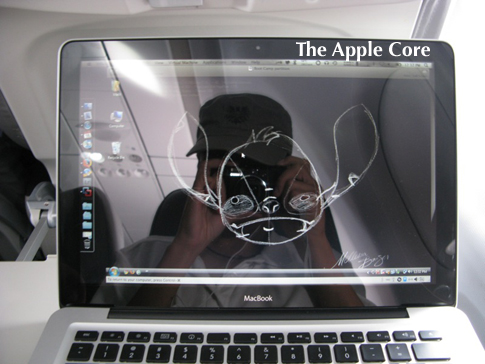Apple reconsidering anti-glare screen options; users rejoice

Apple slowly been converting all of its notebook and iMac displays to highly-reflective glass surfaces shortly after the release of the original iPhone in 2007. It really hit me where it hurts when Apple released the MacBook Air (my dream Mac) exclusively with a glossy screen. I complained about the issue in a January 2008 post Death to the glossy display!
The glossy screen annoys me so because of the incredible amount of glare that it reflects. Sure, it might be ok in a dimly lit studio, but as soon as you’re near an outdoor window it’s as reflective as a mirror. This effect is exponentially worse when used outdoors or in a car, train or airplane–the prime locations for using a notebook computer. Have you ever used a glossy display during the day in a vehicle? It’s horrible. Especially if you have a light-colored shirt on.
Almost 6,000 of you voted in a poll I posted on the topic with two-thirds of you claiming that you disliked glossy displays with the other third being evenly split between loving them and not caring either way. I've added a new poll at the end of this post to see if opinions have changed in 18 months.
In R.I.P. matte screen displays (posted October 2008) I wrote about Apple's troubling trend toward glossy displays and how the company seemed to be ignoring the majority of its customers.
What started as an option on the MacBook Pro, became the only choice on the MacBook. Then the iMac. Then the MacBook Air. Now Apple’s gone 100 percent glossy across their entire line.
Later in October 2008 an Apple Core reader emailed me a picture which pretty much summed up how bad the reflection/glare problem can be with a glossy screens on a notebook, writing:
On the flight I decided to get some work done and was amazed at how unusable this is in non-optimal situations. Like an airplane!? ... for this picture I turned the brightness (up to) 100%, shut the window shade and this is an accurate picture of what I saw.

In January 2009, Apple appeared to concede the point that glossy screens aren't for everyone when they announced the new 17-inch MacBook Pro with a matte screen option. The $50 upcharge for anti-glare was a bit of a slap in the face, but at least it gave users a choice. Then everything went completely down hill when Apple released the rest of the unibody MacBook Pro line with glossy-only displays.
I don't argue that some users prefer glossy screens. I can tolerate them in indoor environments and in low light conditions. Heck, I'll even agree that colors can appear more saturated when viewed on a glossy screen. That's why I'm not calling for Apple to dump glossy entirely, but rather to give users the choice of anti-glare and glossy screens -- for the same price.
A story published yesterday on AppleInsider gives hope to fans of anti-glare screens everywhere indicating that Apple may have realized the error of its glossy ways. AI reports that Apple is "mulling the possibility of extending anti-glare display options to more of its Macs" and that "the 13- and 15-inch MacBook Pros would be the most likely candidates."
Choice is always good for the consumer, pure and simple. No matter where you stand on the glossy vs. matte debate, its hard to argue with choice.
[poll id="182"]